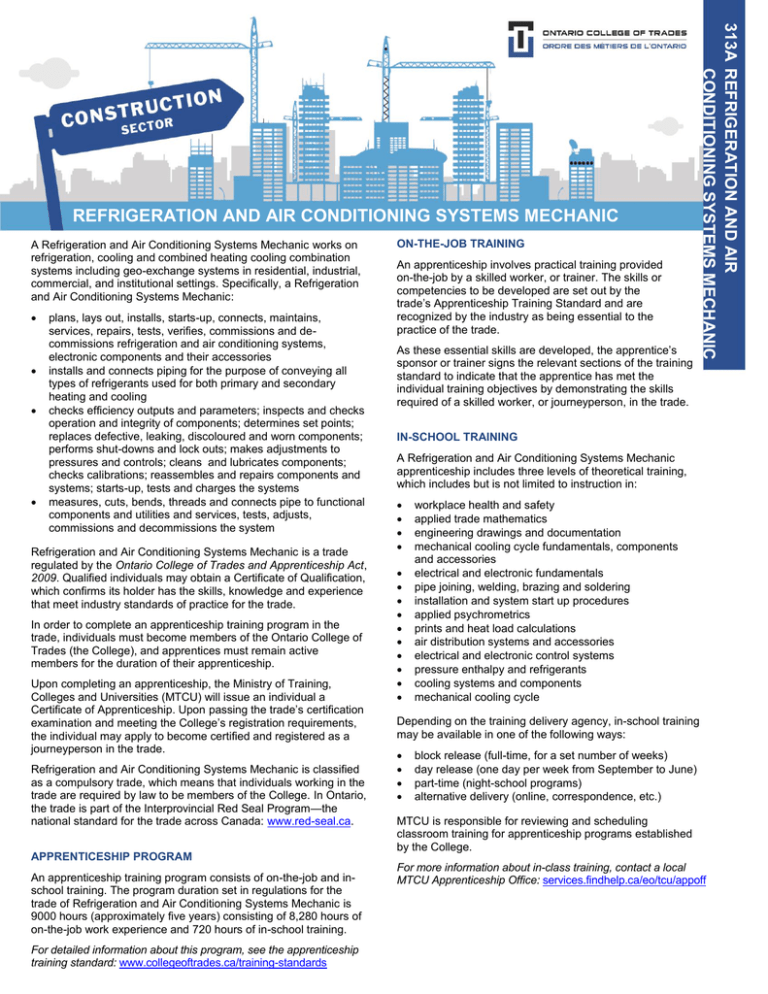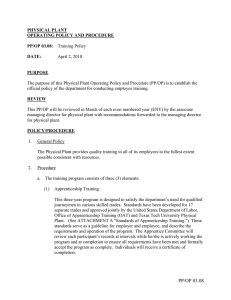REFRIGERATION AND AIR CONDITIONING SYSTEMS MECHANIC
advertisement

A Refrigeration and Air Conditioning Systems Mechanic works on refrigeration, cooling and combined heating cooling combination systems including geo-exchange systems in residential, industrial, commercial, and institutional settings. Specifically, a Refrigeration and Air Conditioning Systems Mechanic: plans, lays out, installs, starts-up, connects, maintains, services, repairs, tests, verifies, commissions and decommissions refrigeration and air conditioning systems, electronic components and their accessories installs and connects piping for the purpose of conveying all types of refrigerants used for both primary and secondary heating and cooling checks efficiency outputs and parameters; inspects and checks operation and integrity of components; determines set points; replaces defective, leaking, discoloured and worn components; performs shut-downs and lock outs; makes adjustments to pressures and controls; cleans and lubricates components; checks calibrations; reassembles and repairs components and systems; starts-up, tests and charges the systems measures, cuts, bends, threads and connects pipe to functional components and utilities and services, tests, adjusts, commissions and decommissions the system Refrigeration and Air Conditioning Systems Mechanic is a trade regulated by the Ontario College of Trades and Apprenticeship Act, 2009. Qualified individuals may obtain a Certificate of Qualification, which confirms its holder has the skills, knowledge and experience that meet industry standards of practice for the trade. In order to complete an apprenticeship training program in the trade, individuals must become members of the Ontario College of Trades (the College), and apprentices must remain active members for the duration of their apprenticeship. Upon completing an apprenticeship, the Ministry of Training, Colleges and Universities (MTCU) will issue an individual a Certificate of Apprenticeship. Upon passing the trade’s certification examination and meeting the College’s registration requirements, the individual may apply to become certified and registered as a journeyperson in the trade. Refrigeration and Air Conditioning Systems Mechanic is classified as a compulsory trade, which means that individuals working in the trade are required by law to be members of the College. In Ontario, the trade is part of the Interprovincial Red Seal Program—the national standard for the trade across Canada: www.red-seal.ca. APPRENTICESHIP PROGRAM An apprenticeship training program consists of on-the-job and inschool training. The program duration set in regulations for the trade of Refrigeration and Air Conditioning Systems Mechanic is 9000 hours (approximately five years) consisting of 8,280 hours of on-the-job work experience and 720 hours of in-school training. For detailed information about this program, see the apprenticeship training standard: www.collegeoftrades.ca/training-standards ON-THE-JOB TRAINING An apprenticeship involves practical training provided on-the-job by a skilled worker, or trainer. The skills or competencies to be developed are set out by the trade’s Apprenticeship Training Standard and are recognized by the industry as being essential to the practice of the trade. As these essential skills are developed, the apprentice’s sponsor or trainer signs the relevant sections of the training standard to indicate that the apprentice has met the individual training objectives by demonstrating the skills required of a skilled worker, or journeyperson, in the trade. 313A REFRIGERATION AND AIR CONDITIONING SYSTEMS MECHANIC REFRIGERATION AND AIR CONDITIONING SYSTEMS MECHANIC IN-SCHOOL TRAINING A Refrigeration and Air Conditioning Systems Mechanic apprenticeship includes three levels of theoretical training, which includes but is not limited to instruction in: workplace health and safety applied trade mathematics engineering drawings and documentation mechanical cooling cycle fundamentals, components and accessories electrical and electronic fundamentals pipe joining, welding, brazing and soldering installation and system start up procedures applied psychrometrics prints and heat load calculations air distribution systems and accessories electrical and electronic control systems pressure enthalpy and refrigerants cooling systems and components mechanical cooling cycle Depending on the training delivery agency, in-school training may be available in one of the following ways: block release (full-time, for a set number of weeks) day release (one day per week from September to June) part-time (night-school programs) alternative delivery (online, correspondence, etc.) MTCU is responsible for reviewing and scheduling classroom training for apprenticeship programs established by the College. For more information about in-class training, contact a local MTCU Apprenticeship Office: services.findhelp.ca/eo/tcu/appoff APPRENTICESHIP FAQ APPRENTICESHIP – WHAT IS IT AND HOW DOES IT WORK? HOW LONG DOES AN APPRENTICESHIP TAKE TO COMPLETE? Apprenticeship is a work-based training program for people who want to work in a skilled trade or occupation. It is also a post-secondary education pathway that provides access to well-paying jobs that require a high level of skill, judgment and creativity. Apprentices are paid while gaining work experience and their wages increase with their skill level. About 90% of apprenticeship training takes place in the workplace, while the remainder consists of theoretical instruction, usually obtained at a college of applied arts and technology or other approved training delivery agency. Apprenticeship training is delivered in partnership by the MTCU and the College. Training agreements between apprentices and sponsors are registered by the MTCU in accordance with legislation. Each individualized training agreements represents workplace training that the sponsor agrees to provide to someone who wants to learn a skilled trade. Apprenticeships take two to five years to complete, depending on the trade. Prior education and related work experience are considered when determining the length of the program at registration. Flexible classroom training options are generally available to meet the specific needs of apprentices and their sponsors. ONTARIO COLLEGE OF TRADES – WHO ARE THEY AND WHAT DO THEY DO? The Ontario College of Trades is the regulatory body for skilled trades professions in Ontario. The College enforces regulations that help protect the public and is committed to promoting the value of working with certified skilled trades professionals. The College also maintains a register of its members including the following membership classes: Journeypersons, Apprentices, Journeyperson Candidates, Tradespersons, and Employers/Sponsors. Individuals with registered training agreements must become members of the College’s Apprentices Class and must remain a member in good standing with the College in order to complete the apprenticeship program. To learn more about the College, call toll-free 1-855-299-0028 or in Toronto, call 647-847-3000 or visit www.collegeoftrades.ca. HOW DOES SOMEONE BECOME AN APPRENTICE? The person finds a sponsor willing to ensure that he or she is provided with training according to the Apprenticeship Training Standard established by the College. A sponsor may be an individual, employer, third-party sponsor group, or any entity able to provide an apprentice with opportunities to learn the skills necessary to practice the trade. The person and the sponsor submit a completed Application for Apprenticeship to the local MTCU Employment Ontario office. MTCU staff will arrange a discussion to assess the person’s eligibility for the program and the sponsor’s ability to provide the required training. Staff will explain the roles and responsibilities of all parties involved in apprenticeship training, including the College, and register the training agreement, MTCU staff will also explain the classroom training options and, together with the sponsor, monitor the apprentice’s progress during the program. For more information on becoming an apprentice, visit: www.earnwhileyoulearn.ca. ARE THERE OTHER PATHWAYS TO APPRENTICESHIP TRAINING? The Co-Op Diploma Apprenticeship program allows students attending college to receive apprenticeship training while earning a diploma. The Pre-Apprenticeship Training program helps unemployed individuals strengthen their skills and increase their eligibility for apprenticeship training in a specific skilled trade. CAN A STUDENT START AN APPRENTICESHIP WHILE ATTENDING HIGH SCHOOL? The Ontario Youth Apprenticeship Program (OYAP) allows high school students to participate in apprenticeship training while earning their high school diploma. Interested students should contact their guidance counsellor or technical teacher for more information. DOES THE GOVERNMENT ENCOURAGE SPONSORS TO HIRE APPRENTICES? The Ontario government provides the Apprenticeship Training Tax Credit to corporations and unincorporated businesses that hire apprentices in certain skilled trades, an Employer Signing Bonus to sponsors who register new apprentices in sectors in which skilled workers are in high demand, and an Employer Completion Bonus to sponsors whose apprentices complete their programs. DOES THE GOVERNMENT PROVIDE FINANCIAL SUPPORT TO APPRENTICES? Apprentices can benefit from the Ontario government’s Apprenticeship Scholarship and Loans for Tools programs. Both the Ontario and the federal government offer grants during and at the completion of the apprenticeship program. HOW CAN I LEARN MORE ABOUT APPRENTICESHIP TRAINING? Visit the MTCU Employment Ontario website at www.ontario.ca/employment, call the MTCU Employment Ontario Contact Centre at 1-800-387-5656 or 416-3254084 for service for the deaf, visit an Employment Ontario office or visit www.tcu.gov.on.ca. Revised: Nov 2015
